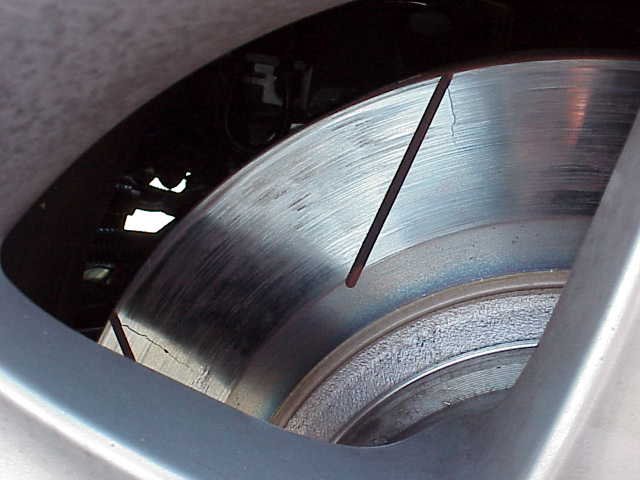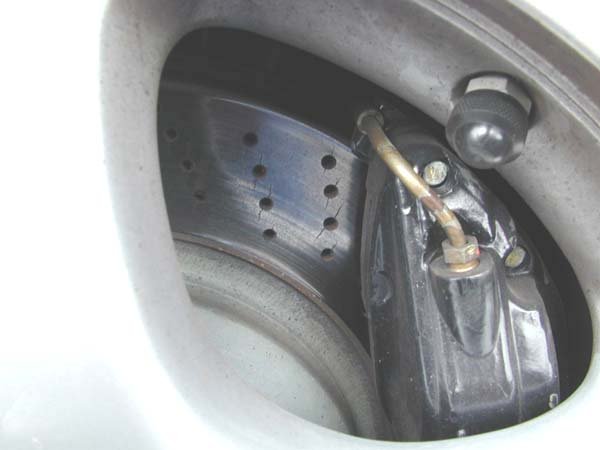You don't understand the interaction between a rotor and the pads. Here is how it works. The friction between the pad and rotor is what causes you to convert energy, and then causes teh tires to stop. This friction converts your forward energy into heat (remember Einstein: Energy is neither created nor destroyed, it is converted). Now that heat is a bad thing. Yes it is bad for the rotors but it is a lot worse for the pads. A warped rotor will still stop the car - it will just feel like ****. Overheated pads however WILL NOT stop the car. It is here where the rotors secondary responsibility comes in. Its job now is to
DISSIPATE the heat away from the pads and
DISPERSE it through itself. Notice that
DISSIPATE and
DISPERSE are interchangeable? Once the heat is removed from the pad/surface area it is then removed. Notice where the removal falls on the list of duties? That's right - number 3. Here is the list again. Memorize it because I will be using it a lot in this post:
#1 Maintains a coefficient of friction with the pad to slow the forward inertia of the vehicle
#2
DISSIPATE the heat
#3 REMOVE the heat from the brake system
Let's look more in-depth at each step now shall we?
#1 Maintains a coefficient of friction with the pad to slow the forward inertia of the vehicle:
This one is pretty simple and self-explanatory. The rotor's surface is where the pads contact and generate friction to slow the vehicle down. Since it is this friction that causes the conversion of forward acceleration into deceleration (negative acceleration if you want) you ideally want as much as possible right? The more friction you have the better your stopping will be. This is reason #1 why BIGGER brakes are the best way to improve a vehicle's consistent stopping ability. More surface area on the pad and the rotor = more friction = better stopping. Does that make sense? Good. Let's move on.
#2 DISSIPATE The Heat:
Let's assume for a second that the vehicle in question is running with Hawk Blue pads on it. The brand doesn't really matter but that is what I am using as my example. They have an operating range of 400 degrees to 1100 degrees. Once they exceed that 1100 degree mark they fade from overheating. The pad material gets too soft to work effectively - glazing occurs. This means that a layer of crude glass forms on the surface of the pad. As we all know glass is very smooth and very hard. It doesn't have a very high coefficient of friction. This is bad - especially when I am coming down the back straight at VIR at 125MPH. Lucky for us the rotor has a job to do here as well. The rotor, by way of thermal tranfer
DISSIPATES the heat throughout itself. This
DISSIPATION lessens the amount of heat at the contact area because it is diluted throughout the whole rotor. The bigger the rotor the better here as well. The more metal it has the more metal the heat can be diluted into. Make sense? This isn't rocket science.
#3 REMOVE the heat from the brake system:
This is the step where the rotor takes the heat it
DISSIPATED from the pads and gets rid of it for good. How does it do this? By radiating it to the surface - either the faces or inside the veins. It is here where cool air interacts with the hot metal to cool it off and remove the heat. Once again there is a reoccuring theme of "the bigger the better" here. The bigger the rotor, the more surface area it will have which means more contact with the cooling air surrounding it. Got it? Good.
Now let's look at why cross-drilling is a bad idea.
First - as we have already established, cross-drilling was never done to aid in cooling. Its purpose was to remove the worn away pad material so that the surfaces remained clean, and give a place for the gases created by heated asbestos a place to go. As we all know this doesn't have much of a purpose nowadays.
Next - In terms of cooling: Yes - x-drilling does create more areas for air to go through but remember - this is step 3 on the list of tasks. Let's look at how this affects steps 1 and 2. The drilling of the rotor removes material from the unit. This removal means less surface area for generating surface friction as well as less material to accept the
DISSIPATED heat that was generated by the friction. Now because of this I want to optimize step one and 2 since those are the immediate needs. If it takes longer for the rotor to get rid of the heat it is ok. You will have a straight at some point where you can rest the brakes and let your cooling ducts do their job. My PRIMARY concern is making sure that my car slows down at the end of the straight. This means that the rotor needs to have as much surface as possible to generate as much friction as possible and it needs to
DISSIPATE the resulting heat AWAY from the pads as quick as possible so they continue to work. In both cases x-drilling does nothing to help the cause.
Now let's talk about strength - and how x-drilled rotors lack it. This one is simple. Explain again just how drilling away material/structure from a CAST product DOES NOT weaken it? Since you are obviously a man of great knowledge and experience surely you have seen what can happen to a x-drilled rotor on track right? Yes it can happen to a non-drilled rotor as well but the odds are in your favor when pimpin' bling-bling drilled y0! Since you are also an expert on thermodynamics why not explain to the group what happens to a cast iron molecule when it is overheated. I will give you a little hint - the covalence bonds weaken. These bonds are what hold the molecules together boys and girls. You do the math - it adds up to fractures.
So why don't race teams use them if they are so much better? Consistency? Hmmmm . . . no. It is because of several factors actually. They are as follows but in no particular order:
- Less usable surface area for generating friction
- Less material to
DISSIPATE the heat away from the pads
- Less reliable and they are a safety risk because of fatigue and stress resulting from the reduced material.


